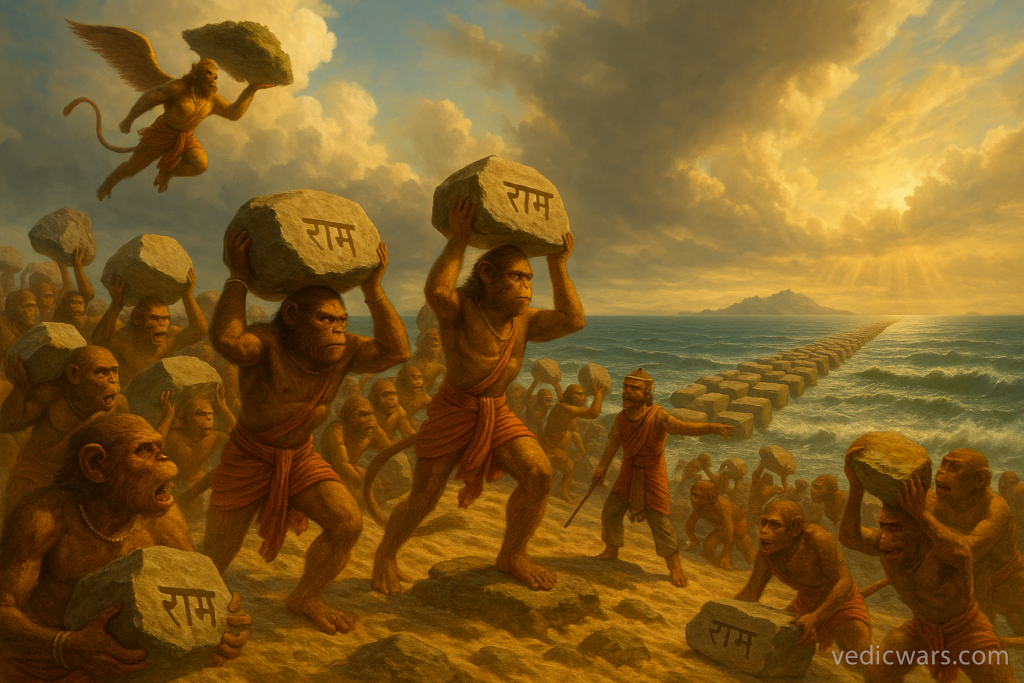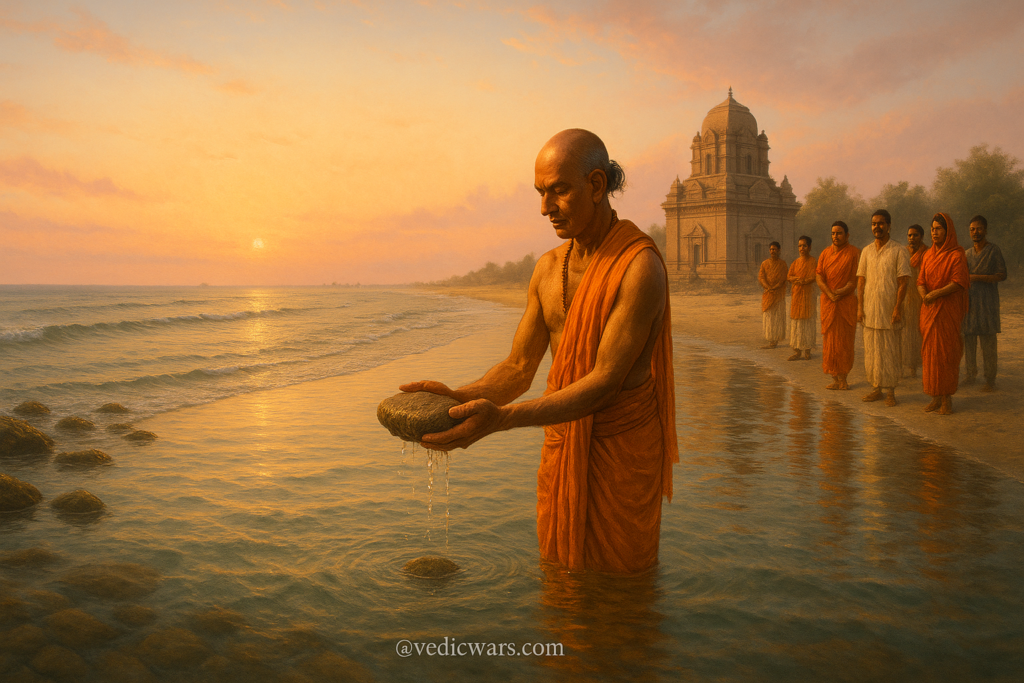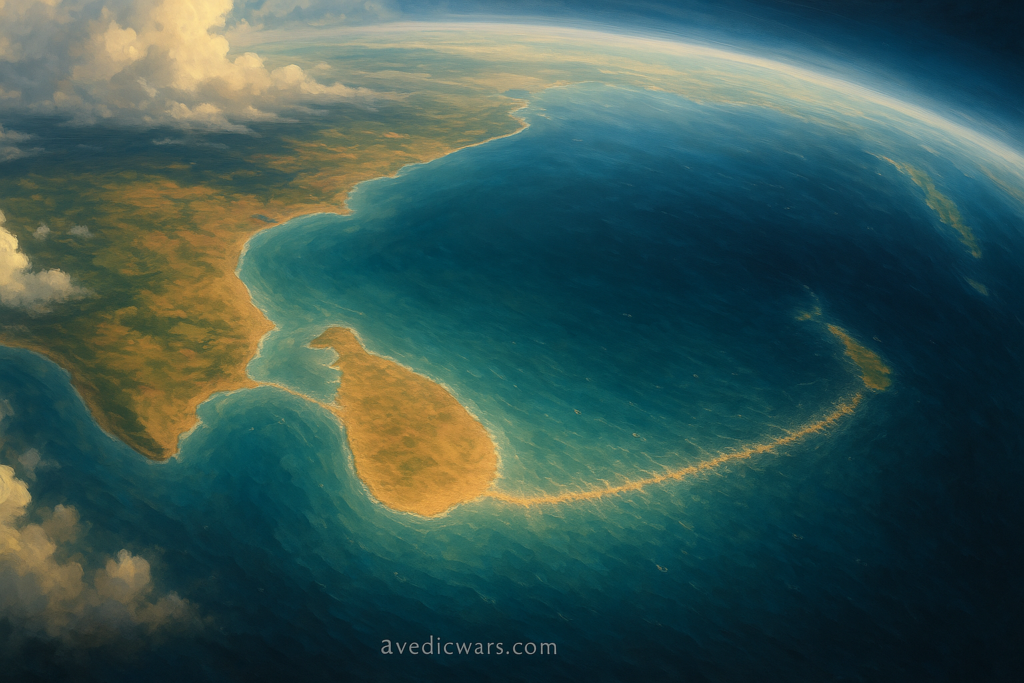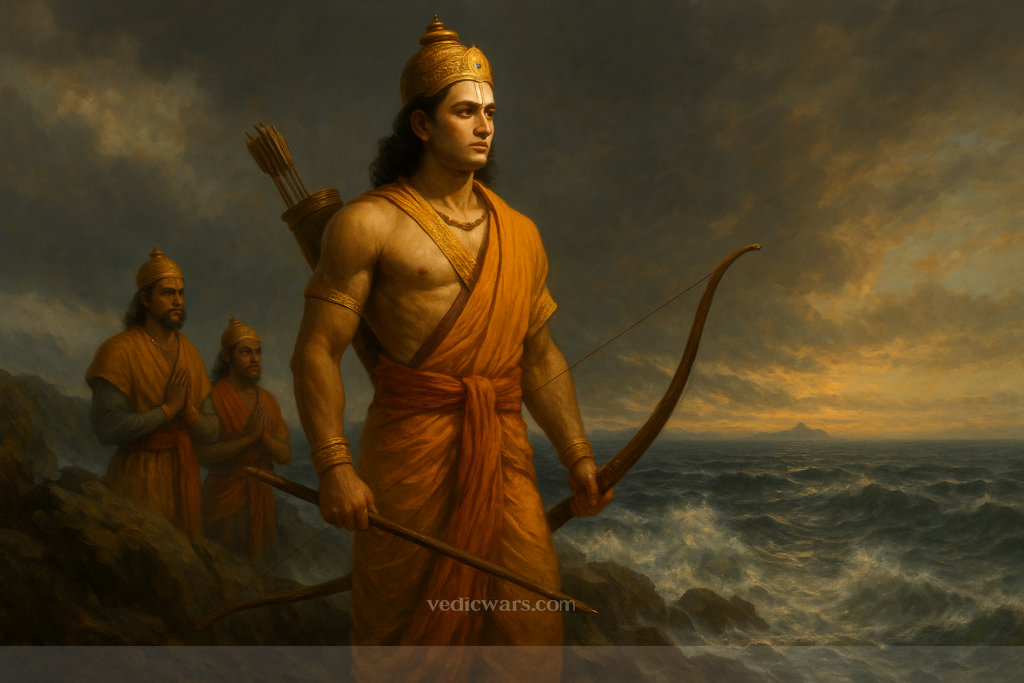📜 Table of Contents
- Introduction: The Legend Beneath the Waves
- Ram Setu Bridge in Valmiki Ramayana
- 2.1 How Rama’s Army Built the Ram Setu Bridge
- 2.2 Dhanushkodi: The Bow’s End
- Scientific and Geological Evidence of Ram Setu Bridge
- 3.1 Satellite Imagery and NASA Clarifications
- 3.2 Indian Geological and Marine Surveys
- Sethusamudram Project and Political Controversy
- 4.1 Public Outcry and Legal Battles
- 4.2 Environmental and National Heritage Perspectives
- Cultural and Regional Beliefs Around Ram Setu Bridge
- 5.1 Pilgrimage Sites and Floating Stones
- 5.2 Rameswaram, Dhanushkodi, and Living Legacy
- Myth vs. Reality: Faith and Fact Intertwined
- Conclusion: What Ram Setu Bridge Represents Today
- FAQ: Ram Setu Questions Answered
Introduction: The Legend Beneath the Waves
In the golden age of heroes, an exiled prince stood at the southern shore of India, gazing toward the vast ocean that separated him from his beloved. That prince was Lord Rama, and beyond the waves lay Lanka, where the demon king Ravana held Sita captive. In that moment of divine resolve, Rama’s Vanara Sena began constructing a legendary bridge — one that still captures the world’s imagination.
Today, the remnants of this path are known as Adam’s Bridge, or more reverently by millions as the Ram Setu bridge. But is it just a string of sandbanks? Or the literal realization of a mythological engineering feat? Let’s explore the origins, science, politics, and living devotion surrounding this timeless marvel.
Ram Setu Bridge in Valmiki Ramayana
The origin of the Ram Setu bridge lies in India’s most revered epic — the Valmiki Ramayana.
How Rama’s Army Built the Ram Setu Bridge

In the Yuddha Kanda (Book of War), Rama reaches the coast at the tip of Bharat, the present-day Tamil Nadu shoreline. Unable to cross the vast ocean, he first prays to Varuna, the god of the sea. When Varuna remains silent, Rama prepares to unleash celestial weapons to dry up the ocean. Varuna then appears and advises him to build a bridge instead.
At Varuna’s suggestion, the Vanara architect Nala, son of Vishwakarma, takes charge. With divine assistance and the tireless work of the Vanara Sena, stones and trees are gathered, floated, and arranged into a massive causeway. The bridge is said to have been completed in just five days, stretching over the sea from Rameswaram to Lanka.
The structure measured 100 yojanas long and 10 yojanas wide — symbolic measurements indicating an awe-inspiring feat. Valmiki describes the Ram Setu bridge glowing “like the Milky Way across the sky,” as gods, sages, and even celestial beings gathered to witness it. Every stone bore Rama’s name and, by his grace, floated — a miracle of devotion and divine engineering.
Dhanushkodi: The Bow’s End

After Rama’s victory over Ravana, the bridge was no longer needed. He asked the newly crowned Lankan king, Vibhishana, how to dismantle it. Vibhishana advised breaking the structure so it wouldn’t be misused in future. Rama took his bow and broke the bridge at a point now known as Dhanushkodi — literally, “Bow’s End.” To this day, this coastal town marks the Indian side of the Ram Setu bridge, rich in mythology and sacred memory.
Locals and pilgrims believe that this was the final earthly mark of Rama’s campaign — a geographic relic of a divine story.
Scientific and Geological Evidence of Ram Setu Bridge
In recent decades, the Ram Setu bridge has attracted intense interest not only from spiritual communities, but also scientists, geologists, and archaeologists. Does physical evidence exist to support the legend?
Satellite Imagery and NASA Clarifications
In 2002, NASA’s Landsat satellite captured striking images showing a submerged, continuous chain of shoals stretching between India and Sri Lanka.To many, this seemed to validate the epic — the mythical Ram Setu bridge appeared to be real and visible from space. Global headlines erupted: “NASA discovers Rama’s Bridge!”

However, NASA officially clarified that satellite imagery does not prove man-made origin. They explained the structure is clearly natural, but determining who built it, or if anyone did, is beyond the scope of remote sensing. Their statement emphasized that “images from orbit cannot provide direct information about whether humans were involved in the bridge’s creation.”
Still, the very existence of a visible, narrow formation exactly where the Ramayana described it fueled curiosity.
Indian Geological and Marine Surveys
In India, several researchers took the study further. Dr. S. Badrinarayanan, a former director at the Geological Survey of India, conducted studies involving core drilling at the site. He discovered a layer of loose sand beneath a top layer of coral, which he argued is unusual. Corals typically grow on rock, not sand.
He interpreted this as possible proof of artificial placement, suggesting that stones were laid on a foundation of sand and later fossilized. Carbon dating from surrounding beaches and coral deposits in the region estimated the structure could be 7,000 years old or more, consistent with post-Ice Age geography.
Some researchers also pointed to the symmetric alignment of the shoals — a feature that doesn’t easily occur in random sandbars. Further support came from ISRO and Indian Council of Historical Research (ICHR), which launched marine archaeology surveys to explore whether tool marks, shaped blocks, or signs of human engineering exist beneath the sea.
Although no definitive proof has emerged, the persistence of anomalies continues to intrigue scientists. Was it a natural ridge adapted by humans, or merely nature mimicking the story? The answers remain submerged — but far from forgotten.
Sethusamudram Project and Political Controversy
The Ram Setu bridge isn’t just a topic of myth and science — it’s also a major flashpoint in Indian political, religious, and environmental discourse.
Public Outcry and Legal Battles
In the early 2000s, the Indian government revived the long-pending Sethusamudram Shipping Canal Project. The plan: to dredge a shipping route through the Palk Strait, connecting India’s east and west coasts. But one obstacle stood in the way — the Ram Setu bridge. To complete the project, parts of the limestone shoals would have to be cut or destroyed.
Religious groups, cultural organizations, and many citizens erupted in protest. They argued that the bridge was sacred, and that destroying it would be an assault on national heritage. A petition reached the Supreme Court of India, while protests intensified on the ground. In 2007, the Archaeological Survey of India (ASI) filed a controversial affidavit, stating there was “no historical proof” that Rama existed, or that the bridge was man-made.
This statement sparked outrage. The government eventually withdrew the affidavit, but the damage was done. Courts ordered a halt to dredging, and the Sethusamudram project was indefinitely stalled.
Environmental and National Heritage Perspectives
The issue wasn’t just religious. Environmentalists pointed out that the Ram Setu bridge acts as a natural breakwater, shielding the Tamil Nadu coast from storm surges and tsunamis. Many believe that during the 2004 tsunami, areas behind Ram Setu were less affected due to this natural barrier. Marine biologists raised alarms about the coral ecosystems, migratory fish, and fragile biodiversity that could be lost if the shoals were damaged.
Even thorium-rich sands (a nuclear resource) in the region raised concerns about irreversible geological loss. Eventually, political leaders pushed for an alternative route, preserving the bridge. More recently, public figures have demanded that Ram Setu be declared a National Monument under the Ancient Monuments and Archaeological Sites and Remains Act.
The proposal has gained traction, and legal recognition may not be far off. Thus, the bridge continues to hold India’s attention — not only for its mythic roots, but for what it means to culture, conservation, and collective identity.
Cultural and Regional Beliefs Around Ram Setu Bridge
Beyond satellite imagery and courtrooms, the Ram Setu bridge lives powerfully in India’s cultural memory. From temples to oral traditions, it is deeply sacred to millions.
Pilgrimage Sites and Floating Stones
At the holy town of Rameswaram, pilgrims worship at the Ramanathaswamy Temple, believed to be where Rama prayed to Lord Shiva before his journey to Lanka. The temple is part of the sacred Char Dham pilgrimage. Nearby, the sea at Agni Theertham is believed to carry the spiritual essence of Rama’s mission.
At many temples in the region, floating stones are displayed — porous volcanic rocks that stay afloat due to trapped air, yet are presented as remnants of the Ram Setu bridge. To the faithful, they are tangible proof of divine construction. Their buoyancy may be explainable by science, but their spiritual weight is immense.
Rameswaram, Dhanushkodi, and Living Legacy
Travel further to Dhanushkodi, the last land point of India before Sri Lanka. Once a thriving town, it was devastated by a cyclone in 1964. Today, it remains partly abandoned — except for a few sacred shrines and a spiritual glow. Local legends identify Dhanushkodi as the place where Vibhishana surrendered, and where Rama broke the bridge with his bow.
The very name means “End of the Bow.” Here, the land literally ends — but the legend begins. Tourists and devotees alike take glass-bottom boat rides over the shallow waters to glimpse the submerged parts of the bridge. Whether or not it’s the exact path walked by Vanaras, standing at Dhanushkodi and gazing toward Sri Lanka awakens something timeless in every traveler.
Myth vs Reality: Faith and Fact Intertwined

The debate over the Ram Setu bridge often becomes a battle between science and faith. But perhaps it’s not a battle — it’s a bridge itself. On one side, we have geologists and remote sensing experts stating that Adam’s Bridge is a natural sediment formation, possibly shaped by ocean currents and ancient sea level changes.
On the other, we have scriptural accounts, oral tradition, and the unwavering faith of millions who believe it was created by Rama’s army. Some scholars propose a middle path — that ancient engineers may have reinforced a natural ridge, and this evolved into legend. Others believe that even if the Vanara Sena were not literal monkeys, they could symbolize a skilled group of tribal workers or forest engineers from a long-lost civilization.
Whatever the truth may be, the Ram Setu bridge stands as a testament to India’s ability to blend epic, memory, and geography into something enduring.
Conclusion: What Ram Setu Bridge Represents Today
More than coral or sand, more than science or legend, the Ram Setu bridge is a powerful symbol.
It bridges two nations — India and Sri Lanka.
It bridges myth and history.
It bridges belief and doubt.
It reminds us that the stories of our ancestors are not just tales — they are blueprints of identity, values, and inspiration. Whether or not it was built stone by stone by a divine prince and his monkey army, the Ram Setu bridge continues to carry meaning that spans oceans of time.
And that may be the greatest engineering marvel of all.
Frequently Asked Questions (FAQ)
Q1. Is the Ram Setu bridge visible today?
Yes. It appears clearly in satellite images and can also be seen in shallow waters by boat from Dhanushkodi or Rameswaram.
Q2. Was Ram Setu built by humans or gods?
According to the Ramayana, it was built by Lord Rama’s Vanara Sena under Nala’s direction. Science suggests it may be a natural formation, possibly enhanced by humans.
Q3. Is Adam’s Bridge the same as Ram Setu?
Yes. “Adam’s Bridge” is the colonial-era name for the same formation known traditionally as Ram Setu bridge.
Q4. Why was the Sethusamudram project controversial?
The proposed canal would damage the bridge, sparking religious and environmental protests. Courts later halted the project.
Q5. Are there really floating stones from the bridge?
Yes. Pumice stones that float have been found and are displayed in temples. Devotees believe they are part of Rama’s bridge.

